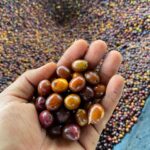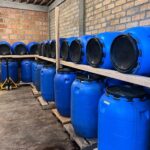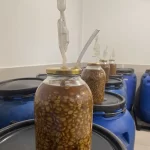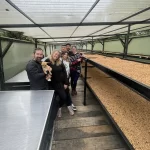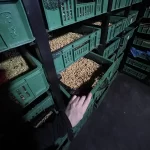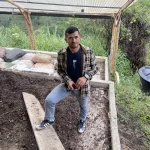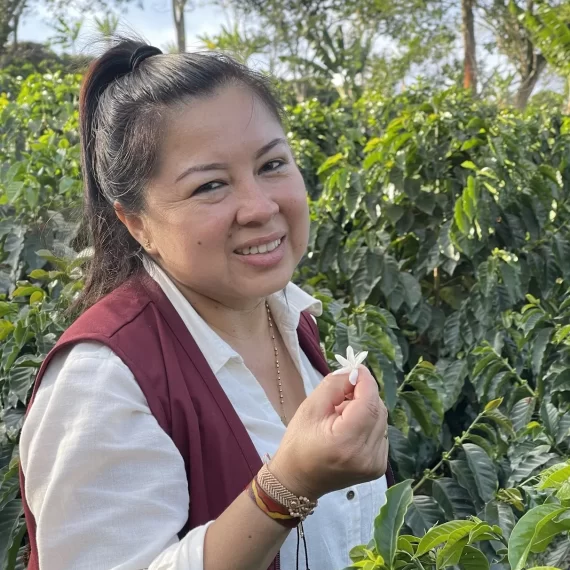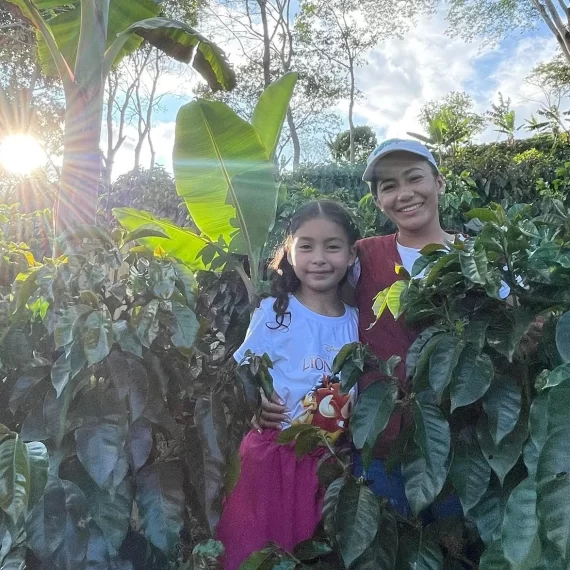
Los Nogales
Los Nogales Farm is a family business, so it is difficult to talk about just one name. But for us, the charismatic Oscar Hernandez, the leader of the project, represents the farm.
Oscar is a third-generation farmer who grows coffee in the south of the department of Huila, near the town of Bruselas. He is an energetic person, always positive and innovative, not only for his family but also for the wider environment. His father, Ricaurte Hernandez, was the first to prove what we know today: that the best coffees from all over Colombia can be found in Bruselas. In 2006, he won the Colombian Cup of Excellence and, as the locals say, spread the word. Ricaurte put Bruselas, and the entire department of Huila, on the map of fine coffee. Oscar continues this tradition, and thanks to him and his approach, Los Nogales is a centre of innovation and information for all the proactive farmers in the area.
about the farm
Finca Los Nogales is a family farm, or rather a company that combines tradition with innovation. It is located in the village of El Diamante, just outside the town of Bruselas in the southern part of the department of Huila. The farm was founded around 1940 by members of the Hernandez family. Its tradition and focus on growing the best coffee was then developed by Mr Ricaurte Hernandéz. After his death, it was unclear for a while what would become of the farm. About six years ago, however, the farm began to prosper under the stewardship of Oscar Hernandéz, Mr Ricaurte’s son, and is now a model for farmers throughout the region.
The three pillars of the Finca Los Nogales concept are:
1. Terroir – the land gives us life and gives it to the coffee plants that grow on it. Los Nogales knows this. If we just exploit the land and don’t take care of it, we will soon have no place to grow coffee. In contrast to intensive farming and the conventional approach to fertilisation, the entire Los Nogales team is thinking about long-term sustainability. They are replacing intensive commercial single-component fertilisers with complex organic humus made from their own coffee processing residues. They are also gradually planting coffee plants further apart on the plantations, reducing the demand on the land. While less intensive, less concentrated and more complex farming means lower yields in the short term, in the long term it ensures that the same land can be used to grow coffee for generations to come.
2. Genetics – The second important ingredient in coffee production is genetic material. That is, the varieties you choose to work with. At Los Nogales Farm you will find traditional indigenous Arabica varieties that have been grown in Colombia since the 18th century, such as týpica, newer hardier varieties such as Castillo or Colombia, but also exotic varieties imported from other countries and continents, such as gesha or Sudan Rume.
3. Science and passion – innovation at Los Nogales. The world of coffee is constantly evolving and the link with scientific knowledge is becoming more and more commonplace, if not a necessity. Oscar therefore draws on the experience of a biochemist, an agricultural engineer, a microbiologist, an experienced accountant and a very capable manager. They are all passionate about what they do, they all pull together and when they have differences of opinion, they see them as an asset.
About the coffee
Coffee processing: hand picked, only ripe cherries are picked by hand from the tree. The selection continues by immersing the whole cherries in water tanks and removing the floating beans, called flotes. This ensures that only the best cherries undergo the fermentation process. Sorted and washed in this way, the cherries are then disinfected with ozone before processing. This ensures that the level of unwanted micro-organisms is kept to a minimum.
Each variety and microlot has its own ‘recipe’. For some, a thermal (heat) shock is used to start the fermentation process; for others, simple oxidation is sufficient. Either way, as Oscar explained to us during our visit, they help to break down the sugars in the cherry pulp and ensure that the subsequent fermentation processes run smoothly.
The microlots then go into the depulper, a grinder that removes the husks from the coffee. The hulls contain valuable sugary juice, which Los Nogales squeezes and uses for fermentation. The dehulled coffee beans are then placed in plastic barrels, mixed with a little water and a sweet, viscous liquid.
It then depends on what fermentation process we want to use for the lot, whether we want lactic acid fermentation to predominate, or some other type of fermentation, or a combination of the two. Accordingly, micro-organisms such as lactobacilli are added to the vats.
After fermentation, the next important step is drying, which preserves the beans. If we dry the coffee too quickly and abruptly, it will not be stable. At Los Nogales, the fermented microlots are dried for 21 days until they reach the ideal moisture content of between 10% and 12%.
As Los Nogales focuses on sustainable coffee farming, one of the key processes is wastewater treatment. The farm has its own wastewater treatment plant.
Variety: Colombia
Process: mosto fermentation
– Selection of ripe fruit. The process begins with the selective picking of only ripe coffee cherries. This ensures optimal sugar content and a full expression of flavours and aromas.
– Cleaning and disinfecting with purified water: The harvested cherries are cleaned and disinfected using treated water. This step removes dirt and helps eliminate harmful micro-organisms.
– Density sorting, floating: The cherries are submerged in water and sorted by density. Ripe, high-quality beans sink, while defective or underdeveloped beans float. This enhances the precision of selection.
– Thermal shock: The cherries are exposed to 90 °C water for 60 seconds. This long thermal fusion helps to pasteurise the cherries and release additional sugars that will enrich the fermentation process.
Removing the skins and extracting the mosto: The cherries are dry-depulped in a modified depulper, which maximises the extraction of juice – the so-called mosto – from the mucilage and skins. This sugary juice is essential for the next stage.
– Fermentation: The beans ferment for 7 days in the extracted mosto, with the addition of pre-fermented coffee yeasts in a 1:4 ratio. These yeasts, originating from earlier fermentations of the same variety, preserve the coffee’s terroir while enhancing its complexity.
– Sun drying: After fermentation, the beans are dried under controlled conditions until they reach a moisture level of 10.5%, which is optimal for storage and flavour development.
Variety: Tabi
Process: mosto fermentation
– Selection of ripe fruit. The process begins with the careful harvesting of only ripe coffee beans. This is the key to obtaining high quality coffee beans, as ripe fruit has optimal flavour and aroma.
– Cleaning and disinfecting with purified water: The harvested coffee beans are thoroughly cleaned and disinfected with treated water. This helps to eliminate impurities and unwanted micro-organisms.
– Density sorting, floating: coffee beans are immersed in water and sorted according to density. Higher density beans tend to sink, while lower density beans float. This helps to separate the good beans from the defective ones.
– Thermal shock: The selected beans are subjected to a thermal shock of 80 °C water for 60 seconds, followed by rapid cooling in cold water of 15 degrees for 3 minutes. This process breaks down the sugars and pasteurises the beans, which contributes to the final taste of the coffee.
– Removing the skins in a wet mill and adding the mosto: the coffee beans are de-pulped from their skins and put into fermentation barrels. To these is added the pressed juice obtained by pressing the skins of the coffee cherries themselves, which contains a large amount of natural sugars – the so-called ‘mosto’. This can improve the flavour profile and add sweet notes to the coffee.
– Fermentation: The coffee beans undergo a fermentation process that lasts 120 hours. During this time, sugars are broken down, affecting the flavour and acidity of the coffee. Pre-fermenting agents are also added, similar to sourdough starter in bread, which can give the coffee unique characteristics.
– Sun drying: Finally, the fermented coffee beans are dried in the sun for 15 days. This step is necessary to reduce the moisture content of the beans to a level suitable for long-term storage and to further develop the coffee’s flavour.
Variety: Yellow Colombia
Process: mosto fermentation
– Selection of ripe fruit. The process begins with the careful harvesting of only ripe coffee beans. This is the key to obtaining high quality coffee beans, as ripe fruit has optimal flavour and aroma.
– Cleaning and disinfecting with purified water: The harvested coffee beans are thoroughly cleaned and disinfected with treated water. This helps to eliminate impurities and unwanted micro-organisms.
– Density sorting, or floating: The coffee beans are immersed in water and sorted according to their density. Higher density beans tend to sink, while lower density beans float. This helps to separate the good beans from the defective ones.
– Thermal shock: The selected beans are subjected to a thermal shock of 80 °C water for 60 seconds, followed by rapid cooling in cold water of 15 degrees for 3 minutes. This process breaks down the sugars and pasteurises the beans, which contributes to the final taste of the coffee.
– Removing the skins in a wet mill and adding the mosto: the coffee beans are de-pulped from their skins and put into fermentation barrels. To these is added the pressed juice obtained by pressing the skins of the coffee cherries themselves, which contains a large amount of natural sugars – the so-called ‘mosto’. This can improve the flavour profile and add sweet notes to the coffee.
– Fermentation: The coffee beans undergo a fermentation process that lasts 120 hours. During this time, sugars are broken down, affecting the flavour and acidity of the coffee. Pre-fermenting agents are also added, similar to sourdough starter in bread, which can give the coffee unique characteristics.
– Sun drying: Finally, the fermented coffee beans are dried in the sun for 15 days. This step is necessary to reduce the moisture content of the beans to a level suitable for long-term storage and to further develop the coffee’s flavour.
Variety: Týpica
Process: mosto fermentation
– Selection of ripe fruit. The process begins with the careful harvesting of only ripe coffee beans. This is the key to obtaining high quality coffee beans, as ripe fruit has optimal flavour and aroma.
– Cleaning and disinfecting with purified water: The harvested coffee beans are thoroughly cleaned and disinfected with treated water. This helps to eliminate impurities and unwanted micro-organisms.
– Density sorting, or floating: The coffee beans are immersed in water and sorted according to their density. Higher density beans tend to sink, while lower density beans float. This helps to separate the good beans from the defective ones.
– Thermal shock: The selected beans are subjected to a thermal shock of 80 °C water for 60 seconds, followed by rapid cooling in cold water of 15 degrees for 3 minutes. This process breaks down the sugars and pasteurises the beans, which contributes to the final taste of the coffee.
– Removing the skins in a wet mill and adding the mosto: the coffee beans are de-pulped from their skins and put into fermentation barrels. To these is added the pressed juice obtained by pressing the skins of the coffee cherries themselves, which contains a large amount of natural sugars – the so-called ‘mosto’. This can improve the flavour profile and add sweet notes to the coffee.
– Fermentation: The coffee beans undergo a fermentation process that lasts 120 hours. During this time, sugars are broken down, affecting the flavour and acidity of the coffee. Pre-fermenting agents are also added, similar to sourdough starter in bread, which can give the coffee unique characteristics.
– Sun drying: Finally, the fermented coffee beans are dried in the sun for 15 days. This step is necessary to reduce the moisture content of the beans to a level suitable for long-term storage and to further develop the coffee’s flavour.
Variety: Caturra
Process: mosto fermentation
– Harvesting only ripe cherries, which is crucial for obtaining high-quality coffee beans to achieve optimal flavor and aroma.
– The harvested coffee beans undergo thorough cleaning and disinfection with clean water. This removes impurities and unwanted microorganisms.
– The coffee beans are immersed in water and sorted by density. Beans with higher density tend to sink, while those with lower density float. This helps separate quality beans from defective ones.
– The selected beans undergo a thermal shock with water at 80°C for 20 seconds, followed by rapid cooling with cold water for 3 to 5 minutes. This process breaks down sugars and pasteurizes the beans, contributing to the final coffee flavor.
– Cleaning the coffee in a wet mill and adding mosto: the cherries are pulped, cleaned of their skins, and sugars obtained from pressing the skins of the coffee cherries themselves are added. This liquid juice is called “mosto”. This can enhance the flavor profile and add sweet notes to the coffee.
– Addition of pre-fermentation agents and fermentation: Pre-fermentation agents similar to sourdough in baking are added to initiate fermentation. The beans ferment for 90 hours, contributing to the development of a distinctive flavor.
– Sun drying for 15 days: The fermented beans are sun-dried. This process ensures that the beans reach optimal moisture for storage.
Variety: Bourbon Ají
Process: mosto fermentation
– Selection of ripe fruit. The process begins with the careful harvesting of only ripe coffee beans. This is key to obtaining high quality coffee beans, as ripe fruit has optimal flavour and aroma.
– Cleaning and disinfection with treated water: The harvested coffee beans undergo a thorough cleaning and disinfection process using treated water. This helps to eliminate impurities and unwanted micro-organisms.
– Density sorting, so-called floating: the coffee beans are immersed in water and sorted by density. Higher density beans tend to sink, while lower density beans float. This helps to separate the good beans from the defective ones.
– Thermal shock: The selected beans are subjected to a thermal shock of 80 °C water for 20 seconds, followed by rapid cooling in cold water for 3 to 5 minutes. This process breaks down the sugars and pasteurises the beans, which contributes to the final taste of the coffee.
– Removing the skins in a wet mill and adding the mosto: the coffee beans are de-pulped from their skins and put into fermentation barrels. To these is added the pressed juice obtained by pressing the skins of the coffee cherries themselves, which contains a large amount of natural sugars – the so-called ‘mosto’. This can improve the flavour profile and add sweet notes to the coffee.
– Fermentation. The coffee cherries undergo a fermentation of 120 hours. During this time, sugars are broken down, which affects the coffee’s flavour and acidity. Also mentioned is the addition of pre-ferments, similar to sourdough starter in bread, which can add unique characteristics to the coffee.
– Sun drying: Finally, the fermented coffee beans are dried in the sun for 15 days. This step is necessary to reduce the moisture content of the beans to a level suitable for long-term storage and to further develop the coffee’s flavour.
Variety: Bourbon Ají
Process: mosto fermentation
– Harvesting only ripe cherries is crucial for obtaining high-quality coffee beans, as ripe beans have optimal flavor and aroma.
– The harvested coffee beans undergo thorough cleaning and disinfection with pure water. This removes impurities and unwanted microorganisms.
– The coffee beans are immersed in water and sorted by density. Beans with higher density tend to sink, while those with lower density float. This helps separate quality beans from defective ones.
– The coffee cherries are pulped, skinned, and sugars obtained from pressing the skins of the cherries themselves are added. This pressed juice is called “mosto”. This can enhance the flavor profile and add sweet notes to the coffee.
– The coffee beans undergo a fermentation process lasting 48 hours at 15 degrees Celsius. During this time, sugars are broken down, affecting the flavor and acidity of the coffee. It’s also important to mention the addition of pre-ferments, similar to sourdough in bread, which can give the coffee unique characteristics.
– Finally, the fermented coffee beans are sun-dried for 15 days. This step is necessary to reduce the moisture content of the beans to a level suitable for long-term storage and to further develop the coffee’s flavor.
Variety: Pink Bourbon
Process: mosto fermentation
– Harvesting only ripe cherries is crucial for obtaining high-quality coffee beans, as ripe beans have optimal flavor and aroma.
– The harvested coffee beans undergo thorough cleaning and disinfection with pure water. This removes impurities and unwanted microorganisms.
– The coffee beans are immersed in water and sorted by density. Beans with higher density tend to sink, while those with lower density float. This helps separate quality beans from defective ones.
– The coffee cherries are pulped, skinned, and sugars obtained from pressing the skins of the cherries themselves are added. This pressed juice is called “mosto”. This can enhance the flavor profile and add sweet notes to the coffee.
– The coffee beans undergo a fermentation process lasting 48 hours at 15 degrees Celsius. During this time, sugars are broken down, affecting the flavor and acidity of the coffee. It’s also important to mention the addition of pre-ferments, similar to sourdough in bread, which can give the coffee unique characteristics.
– Finally, the fermented coffee beans are sun-dried for 15 days. This step is necessary to reduce the moisture content of the beans to a level suitable for long-term storage and to further develop the coffee’s flavor.




